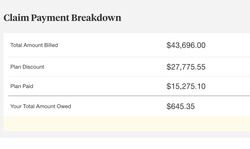 |
| Angelika/Mike Schilli |
|
|
|
Michael Last summer, I had the dubious pleasure of having my meniscus, which I tore playing soccer, surgically repaired. In Figure 2, you can see the total cost of this adventure. The hospital charged a whopping $43,696. However, our health insurance had a deal with the place, so we got a discount of $27,775.55, leaving $15,275.10, which the insurance actually paid. That means everything except for the so-called "Copay," a deductible of $645.35, was charged to me as the patient. What went on there?
Health insurance companies in America offer, either through an employer or a government agency like Covered California various so-called "plans," which are insurance contracts at different costs. Typically, the insured pays a monthly premium but often must also chip in a co-payment for medical bills. For example, our co-payment is $30 for doctor visits, but for more extensive procedures during hospital visits, it's a hefty 10% of the bill, up to an annual maximum of $2,000. This is intended to motivate patients to minimize visits to the doctor or other costs. For plans with lower deductibles, the insured must pay correspondingly higher monthly premiums.
Under our plan, until we reach the yearly maximum (in the example, $2,000 per year), each doctor visit costs us $30. So, if the insurance company agrees to pay the doctor $400 for a 10-minute visit (which is not unusual as health costs are out of control), because that's the negotiated rate between the doctor and the insurance company, the insurance later transfers only $370 to the doctor. The remaining $30 must be collected by the doctor from the patient. This is usually handled at the reception desk, where the patient typically pays the owed amount by credit card in advance, before even seeing a doctor. However, sometimes the staff forgets to collect the copay, and a few weeks later, the delighted patient receives a bill for $30 by mail, which they can also usually pay by credit card.
During my aforementioned operating room visit last year, the hospital's finance people mysteriously estimated the cost of the surgery at $9,000, and a few days before the appointment, they charged me 10% of that amount, or $900, which I paid by credit card, to give the go-ahead for the surgery. However, in the meantime, several charges from various other service providers had been filed with the insurance: the radiologist wanted money, as well as the treating orthopedist who had recommended surgery after an also expensive MRI. Quickly, my annual maximum amount of $2,000 had been reached. Hooray? That's why, later, despite the higher-than-estimated surgery costs ($15,275.10 instead of $9,000), the insurance calculated my co-pay not as $900, but only as $645.35. Wait a minute, so had I overpaid the hospital by $254.65?
Now, it must be said that many Americans wouldn’t bother to check this, but you might have heard that I once called eBay to get a refund of 10 cents that those crooks had overcharged me. So, I called the hospital, navigated through a thousand menu options, and asked if I would get my money back. No, they told me, I was lucky because the insurance had negotiated a lower amount. Apparently, the finance person on the phone had no clue because, according to my research, my insurance had reimbursed the hospital the requested amount except for exactly $645.35, which I was willing to contribute, but not a penny more. The hospital lady advised me to call my health insurance to clear up the matter.
I got right on it. Since our health insurance is still managed through my old employer, the staff there are incredibly sharp, quite different from what one typically expects of health insurances in America. The employee on the hotline immediately saw the problem and, while I was still on the phone, contacted the hospital. Apparently, the billing department there got an earful because, after a few minutes, I received the pleasing news that the hospital would of course refund my money immediately.
What do we learn from this? Not even billing departments of hospitals know how to bill correctly. Most patients are also overwhelmed by the regulations or unwilling to familiarize themselves with them, and out of ignorance, they leave their hard-earned money on the table. The service providers may even factor this in and keep quiet if the patient overpays, while in the opposite case, they of course immediately pull all levers to receive the cash.
So, as always in America: Keep calling until everything is correct. Be friendly but assertive, never scold, but patiently explain the situation and maybe even inject a bit of humor. After all, the people on the other end of the line are just humans doing a tedious job and yearning for some entertainment. At the same time, you get to improve your English and negotiation skills for free.
Anyways, four weeks later, a letter from the hospital arrived in our mailbox via snail mail, with a cover letter that defiantly claimed that an 'Internal Audit' conducted by the hospital had discovered that too much money had been taken from me. Enclosed was a check for the exact $254.65 I had disputed. Life is full of coincidences.













